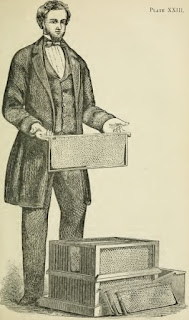Philippine bee keepers need to beware of "over engineering" and keep to basic Langstroth principles in my opinion. Foundation is b...
Philippine bee keepers need to beware of "over engineering" and keep to basic Langstroth principles in my opinion. Foundation is bad. Natural comb is good. Amen.
Dadant got hold of Langstroth's book and re-published it to promote the family business of selling foundation. Going back to Langstroths actual book is educational. Dadant is still to be admired as his stackable boxes are what we still use.
What we call Langstroth frames are usually Hoffman self spacing frames designed so non-beekping staff of commercial beekeepers could not mess up the spacing. The top of the sidebars is wider than it should be to stop the frames being placed too close together by the untrained and ill informed. If you plan on being a real beekeeper with an understanding of Bee-Space then you should use true Langstroth frames with proper spacing for the conditions. The Philippines is not the same as the USA with its cold winters.
" The triangular pieces, represented in many of the engravings, not answering the ends intended, I return to the shape originally used. The Winter passage which was suggested for trial is also discarded." Rev. Langstroth
So Langstroth did not use the frame that is in his book. It has caused so much confusion that many people think the Hoffman is his frame. The Hoffman is not made for good BeeKeepers. Langstroth would have hated it.
These are his notes about frames at the end of the book...
"With regard to its width and length, a frame may be stiffened by driving one nail through each end into it. All the parts of the movable frames should be cut out by circular saws, and the measurements should be exact, so that the frames when nailed together may be square. If they are not strong and perfectly square, the proper working of the hive will be greatly interfered with. Ten single, or five double frames, equally distant from each other, are placed in the lower hive, and nine single frames, or four double frames and one single one, may be placed in the upper hive, for surplus honey."
One nail per corner folks. Narrow spacing for brood and wider for honey.
Dadant got hold of Langstroth's book and re-published it to promote the family business of selling foundation. Going back to Langstroths actual book is educational. Dadant is still to be admired as his stackable boxes are what we still use.
What we call Langstroth frames are usually Hoffman self spacing frames designed so non-beekping staff of commercial beekeepers could not mess up the spacing. The top of the sidebars is wider than it should be to stop the frames being placed too close together by the untrained and ill informed. If you plan on being a real beekeeper with an understanding of Bee-Space then you should use true Langstroth frames with proper spacing for the conditions. The Philippines is not the same as the USA with its cold winters.
Top bars, Side bars and Bottom Bars are all the same width. The top bar has a wooden starter guide in it.
Part of the confusion is that in Langstroth's book he thought he had found a better way just before publication. He experimented with a bar with starter strips on all sides and a "winter passage" in the center.
bs - stands for BeeSpace
But the frame was a failure. The later editions continued to carry the picture of the failed design (because it was too expensive to redo the plates in the old days) but with a note at the end of the book reading...
" The triangular pieces, represented in many of the engravings, not answering the ends intended, I return to the shape originally used. The Winter passage which was suggested for trial is also discarded." Rev. Langstroth
So Langstroth did not use the frame that is in his book. It has caused so much confusion that many people think the Hoffman is his frame. The Hoffman is not made for good BeeKeepers. Langstroth would have hated it.
This is Langstroth and his frames. From his book but gets overlooked.
"With regard to its width and length, a frame may be stiffened by driving one nail through each end into it. All the parts of the movable frames should be cut out by circular saws, and the measurements should be exact, so that the frames when nailed together may be square. If they are not strong and perfectly square, the proper working of the hive will be greatly interfered with. Ten single, or five double frames, equally distant from each other, are placed in the lower hive, and nine single frames, or four double frames and one single one, may be placed in the upper hive, for surplus honey."
Rev. Langstroth



